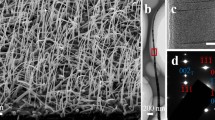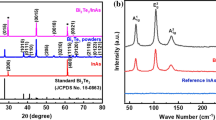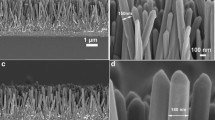Abstract
In this work, selective radiation material was used to change heat transport of hot side, a novel heterostructure cooler, constructed by gold (Au)—bismuth telluride (Bi2Te3) nanowires array was reported experimentally. The heterostructure was fabricated by electrochemical deposition based on porous anodic alumina template (AAO). The Au nanowire cluster array is used as an infrared selective radiation surface to optimize heat transport of the heat side. And the Bi2Te3 nanowires generate thermoelectromotive force between the two sides of the device due to thermoelectric effect. More interestingly, the Au nanowire ends produce an interface between the metal and semiconductor to enhance the temperature difference, as the interfacial phonon scattering suppresses thermal conductivity. The co-effects create a linear-like relationship between the temperature difference and the applied heating strength to make the heating source hide from infrared detection. At a heating temperature of 170 °C, the radiation temperature difference arrives 16 °C in the Au–Bi2Te3 heterojunction, (increased by 200% to that in Bi2Te3 single phase), given by an intriguing demonstration of infrared camouflage effect. The Au–Bi2Te3 nanowires heterojunction device can not only realize infrared camouflage, but also convert the heat into electrical energy, which provides a new idea for the development of materials.







Similar content being viewed by others
References
Hossain MM et al (2015) A metamaterial emitter for highly efficient radiative cooling. Adv Opt Mater 3(8):1047–1051. https://doi.org/10.1002/adom.201570046
Zhu L, Raman AP, Fan S (2015) Radiative cooling of solar absorbers using a visibly transparent photonic crystal thermal blackbody. Proc Natl Acad Sci 122(40):12282–12287. https://doi.org/10.1073/pnas.1509453112
Li W, Shi Y, Chen Z, Fan S (2018) Photonic thermal management of colored objects. Nat Commun 9(1):1–8. https://doi.org/10.1038/s41467-018-06535-0
Rephaeli E, Raman A, Fan S (2013) Ultrabroadband photonic structures to achieve high-performance daytime radiative cooling. Nano Lett 13(4):1457–1461. https://doi.org/10.1021/nl4004283
Peng L, Liu D, Cheng H (2019) Design and fabrication of the ultrathin metallic film based infrared selective radiator. Sol Energy Mater Sol Cells 193:7–12. https://doi.org/10.1016/j.solmat.2018.12.039
Wu D, Liu C, Xu Z et al (2018) The design of ultra-broadband selective near-perfect absorber based on photonic structures to achieve near-ideal daytime radiative cooling. Mater Des 139(FEB):104–111. https://doi.org/10.1016/j.matdes.2017.10.077
Ono M, Chen K, Li W, Fan S (2018) Self-adaptive radiative cooling based on phase change materials. Opt Express 26(18):A777–A787. https://doi.org/10.1364/OE.26.00A777
Atiganyanun S, Plumley JB, Han SJ, Hsu K, Cytrynbaum J, Peng TL, Han SM, Han SE (2018) Effective radiative cooling by paint-format microsphere-based photonic random media. ACS Photon 5(4):1181–1187. https://doi.org/10.1021/acsphotonics.7b01492
Ollier E, Szambolics H, Dunoyer N, Lorin G (2017) Nanostructured thin films for solar selective absorbers and infrared selective emitters. Sol Energy Mater Sol Cells Int J Photovolt Phototherm Photochem Sol Energy Convers 170:205–210. https://doi.org/10.1016/j.solmat.2017.05.073
Nath J, Modak S et al (2015) Far-infrared absorber based on standing-wave resonances in metal-dielectric-metal cavity. Opt Express 23(16):20366–20380. https://doi.org/10.1364/OE.23.020366
Lin Y, Peiheng Z, Taixing H et al (2017) Broadband thermal tunable infrared absorber based on the coupling between standing wave and magnetic resonance. Opt Mater Express 7(8):2767–2776. https://doi.org/10.1364/OME.7.002767
Montoya JA, Tian ZB, Krishna S, Padilla WJ (2017) Ultra-thin infrared metamaterial detector for multicolor imaging applications. Opt Express 25(19):23343–23355. https://doi.org/10.1364/OE.25.023343
Raman AP, Anoma MA, Zhu L, Rephaeli E, Fan S (2014) Passive radiative cooling below ambient air temperature under direct sunlight. Nature 515:540–544. https://doi.org/10.1038/nature13883
Chen Z, Zhu L, Raman A, Fan S (2016) Radiative cooling to deep sub-freezing temperatures through a 24-h day–night cycle. Nat Commun 7:13729. https://doi.org/10.1038/ncomms13729
Yang F, Jiang Y, Su Y, Wei D, Ma Y (2018) Daytime passive radiative cooler using porous alumina. Sol Energy Mater Sol Cells 191:50–54. https://doi.org/10.1016/j.solmat.2018.10.027
Wang S, Wang Y, Zhang S, Zheng WH (2016) Mid-infrared broadband absorber of full semiconductor epi-layers. Phys Lett A 381(16):1439–1444. https://doi.org/10.1364/CLEO_AT.2016.ATh1J.7
Ai W, Zhou P, Sun R et al (2018) Control of resonance absorption modes for broadband infrared metamaterial absorber. IEEE Photon J PP(99):1–1. https://doi.org/10.1109/JPHOT.2018.2885222
Chen WH, Wang CC, Hung CI (2014) Geometric effect on cooling power and performance of an integrated thermoelectric generation-cooling system. Energy Convers Manag 87:566–575. https://doi.org/10.1016/j.enconman.2014.07.054
Oswaldo AJ, Nelson C, Samara DS (2018) Characterization of a thermoelectric generator (TEG) system for waste heat recovery. Energies 11(6):1555. https://doi.org/10.3390/en11061555
Yu J, Zhu Q, Kong L, Zhu H (2020) Modeling of an integrated thermoelectric generation–cooling system for thermoelectric cooler waste heat recovery. Energies 13:4691. https://doi.org/10.3390/en13184691
Lamba R, Kaushik SC (2017) Thermodynamic analysis of thermoelectric generator including influence of Thomson effect and leg geometry configuration. Energy Convers Manag 144(15):388–398. https://doi.org/10.1016/j.enconman.2017.04.069
Yang L, Chen ZG, Hong M, Guang H, Jin Z (2015) Enhanced thermoelectric performance of nanostructured Bi2Te3 through significant phonon scattering. ACS Appl Mater Interfaces 7(42):23694–23699. https://doi.org/10.1021/acsami.5b07596
Hu HM, Ge TS, Dai YJ, Wang RZ (2015) Analysis on Bi2Te3 thermoelectric cooler with silica aerogel encapsulation. Energy Convers Manag 103:981–990. https://doi.org/10.1016/j.enconman.2015.07.015
Feng H, Tong X, Pengfei Q, Tianran W, Dudi R, Xun S, Lidong C (2018) Enhanced thermoelectric performance in n-type Bi2Te3-based alloys via suppressing intrinsic excitation. ACS Appl Mater Interfaces 10(25):21372–21380. https://doi.org/10.1021/acsami.8b06533
Zhao D, Tan G (2014) A review of thermoelectric cooling: materials, modeling and applications. Appl Therm Eng 66(1–2):15–24. https://doi.org/10.1016/j.applthermaleng.2014.01.074
Zhan Z, Elkabbash M, Li Z, Li X, Zhang J, Rutledge J, Singh S, Guo C (2019) Enhancing thermoelectric output power via radiative cooling with nanoporous alumina. Nano Energy 65:104060. https://doi.org/10.1016/j.nanoen.2019.104060
Ishii S, Dao TD, Nagao T (2020) Radiative cooling for continuous thermoelectric power generation in day and night. Appl Phys Lett 117(1):013901. https://doi.org/10.1063/5.0010190
Kim W, Zide J, Gossard A, Klenov D, Stemmer S, Shakouri A, Majumdar A (2006) Thermal conductivity reduction and thermoelectric figure of merit increase by embedding nanoparticles in crystalline semiconductors. Phys Rev Lett 96(4):045901. https://doi.org/10.1103/PhysRevLett.96.045901
Wenxin L, Wangchen Z, Yanpeng Z et al (2019) Effect of deposition potential and concentration of electroactive substances on Bi2Te3 nanowires fabricated by electrochemical method. Nanotechnology 30(24):245702. https://doi.org/10.1088/1361-6528/ab0bde
Sander MS, Prieto AL, Gronsky R, Sands T, Stacy AM (2002) Fabrication of High-density, high aspect ratio, large-area bismuth telluride nanowire arrays by electrodeposition into porous anodic alumina templates. Adv Mater 14(9):665–667. https://doi.org/10.1002/1521-4095(20020503)14:93.0.CO;2-B
Zhao X, Wu Y, Hao X (2013) Electrodeposition synthesis of Au-ZnO hybrid nanowires and their photocatalytic properties. Int J Electrochem Sci 8:3349–3356. https://doi.org/10.1016/j.electacta.2013.01.029
Kim D, Kim J, Park HC, Lee KH, Wang H (2007) A superhydrophobic dual-scale engineered lotus leaf. J Micromech Microeng 18(1):015019. https://doi.org/10.1088/0960-1317/18/1/015019
Dawood MK, Zheng H, Kurniawan NA et al (2012) Modulation of surface wettability of superhydrophobic substrates using Si nanowire arrays and capillary-force-induced nano-cohesion. Soft Matter 8(13):3549–3557. https://doi.org/10.1039/C2SM07279C
Dawood MK, Zheng H, Liew TH, Leong KC, Foo YL, Rajagopalan R, Khan SA, Choi WK (2011) Mimicking both petal and lotus effects on a single silicon substrate by tuning the wettability of nanostructured surfaces. Langmuir 27(7):4126–4133. https://doi.org/10.1021/la1050783
Dawood MK, Zhou L, Zheng H, Cheng H, Wan G, Rajagopalan R, Too HP, Choi WK (2012) Nanostructured Si-nanowire microarrays for enhanced-performance bio-analytics. Lab Chip 12(23):5016–5024. https://doi.org/10.1039/C2LC40673J
Chakraborty I, Singh N, Gohil S, Ghosha S, Ayyub P (2013) Clustered copper nanorod arrays: A new class of adhesive hydrophobic materials. Soft Matter 9(48):11513–11520. https://doi.org/10.1039/C3SM52243A
Xu Z (2016) Heat transport in low-dimensional materials: a review and perspective. Theor Appl Mech Lett 6(3):113–121. https://doi.org/10.1016/j.taml.2016.04.002
Kou JL, Jurado Z, Zhen C, Fan S, Minnich AJ (2017) Daytime radiative cooling using near-black infrared emitters. ACS Photon 4(3):626–630. https://doi.org/10.1021/acsphotonics.6b00991
Joshi G, Lee H, Lan Y et al (2008) Enhanced thermoelectric figure-of-merit in nanostructured p-type silicon germanium bulk alloys. Nano Lett 8(12):4670–4674. https://doi.org/10.1021/nl8026795
Zhao LD, Dravid VP, Kanatzidis MG (2013) The panoscopic approach to high performance thermoelectrics. Energy Environ Sci 7(1):251–268. https://doi.org/10.1039/c3ee43099e
Callaway J (1959) Model for lattice thermal conductivity at low temperatures. Phys Rev 113(4):1046-1051. https://doi.org/10.1103/physrev.113.1046
Chen ZG, Han G, Yang L, Cheng LN, Zou J (2012) Nanostructured thermoelectric materials: Current research and future challenge. Prog Nat Sci Mater Int 22(6):535–549. https://doi.org/10.1016/j.pnsc.2012.11.011
Islam SS. Semiconductor physics and devices. ISBN: 7302075301
Bernard V, Staffa E, Mornstein V (2013) Infrared camera assessment of skin surface temperature–effect of emissivity. Phys Med 29(6):583–591. https://doi.org/10.1016/j.infrared.2020.103234
Soori A, Kowsary F, Kasraei S (2020) Experimental estimation of the emissivity of human enamel and dentin. Infrared Phys Technol 106:103234. https://doi.org/10.1016/j.infrared.2020.103234
Acknowledgements
This work was supported by the National Natural Science Foundation of China (NSFC) (Nos. 61471097, 52022018, 51802037), by the program of China Scholarships Council under Grant Number 201906070047 and the Program for Changjiang Scholars and Innovative Research Team in University.
Author information
Authors and Affiliations
Corresponding author
Additional information
Handling Editor: Catalin Croitoru.
Publisher's Note
Springer Nature remains neutral with regard to jurisdictional claims in published maps and institutional affiliations.
Supplementary Information
Below is the link to the electronic supplementary material.
Rights and permissions
About this article
Cite this article
Li, W., Liu, Y., Zhao, W. et al. Cooling property and application of Au–Bi2Te3 heterojunction nanowire array based on AAO template. J Mater Sci 56, 10892–10904 (2021). https://doi.org/10.1007/s10853-021-05973-4
Received:
Accepted:
Published:
Issue Date:
DOI: https://doi.org/10.1007/s10853-021-05973-4




